

Compact Muon Solenoid
LHC, CERN
| CMS-PAS-FTR-18-006 | ||
| Search for heavy composite Majorana neutrinos at the High-Luminosity and the High-Energy LHC | ||
| CMS Collaboration | ||
| December 2018 | ||
| Abstract: The sensitivity of a search for heavy Majorana neutrinos with the CMS Phase-2 detector in a final state with two leptons and at least one large-radius jet is investigated. Such new particles arise in theories beyond the standard model with compositeness. The study is based on searches previously performed with Run 2 CMS data, where no evidence for a signal was found. The High-Luminosity LHC (HL-LHC) with a centre-of-mass energy of 14 TeV and an integrated luminosity of 3 ab−1 will allow an extension of the sensitivity to cross sections of order of a few ab for heavy neutrino masses M(Nℓ) ranging from 3 to 9 TeV for the ℓℓqˉq′ channel, where ℓ is an electron or a muon and q is a quark. For the compositeness scale Λ=M(Nℓ), the existence of a heavy Majorana neutrino could be excluded for masses up to 8 TeV at the 95% confidence level. The projection of the study to the High-Energy LHC (HE-LHC) scenario, with a centre-of-mass energy of 27 TeV, is also presented here. | ||
| Links: CDS record (PDF) ; inSPIRE record ; CADI line (restricted) ; | ||
| Figures | |

png pdf |
Figure 1:
The production of a heavy composite Majorana neutrino via the fermion interaction discussed in the text as a sum of the gauge and contact contributions. |
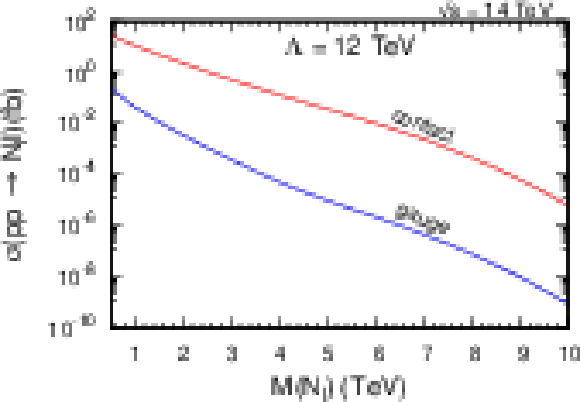
png pdf |
Figure 2:
Production cross sections of the heavy composite Majorana neutrino for gauge and contact interactions at Λ= 12 TeV for pp collisions at √s= 14 TeV, obtained with CalcHEP (v3.6) [29]. |

png pdf |
Figure 3:
Decay amplitude of the heavy composite Majorana neutrino to a lepton and two quarks, for Λ= 5 TeV (left), Λ= 15 TeV (centre), and Λ= 25 TeV (right), as a function of its mass, obtained with CalcHEP (v3.6) [29]. The x-axis range has been restricted to emphasize the interplay. |
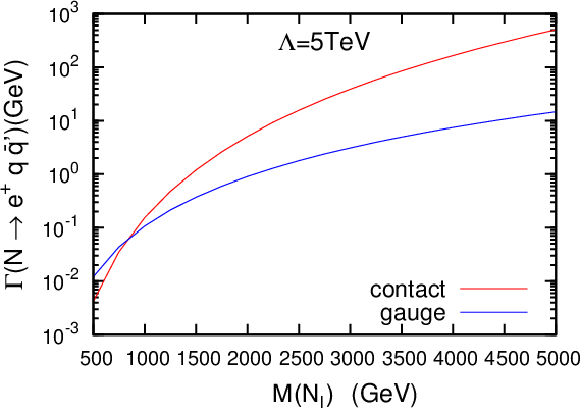
png pdf |
Figure 3-a:
Decay amplitude of the heavy composite Majorana neutrino to a lepton and two quarks, for Λ= 5 TeV, as a function of its mass, obtained with CalcHEP (v3.6) [29]. The x-axis range has been restricted to emphasize the interplay. |
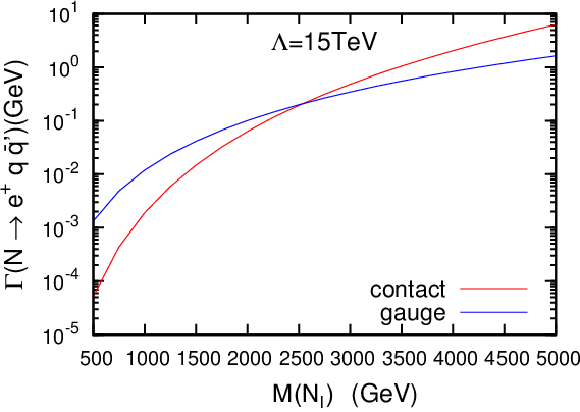
png pdf |
Figure 3-b:
Decay amplitude of the heavy composite Majorana neutrino to a lepton and two quarks, for Λ= 15 TeV, as a function of its mass, obtained with CalcHEP (v3.6) [29]. The x-axis range has been restricted to emphasize the interplay. |
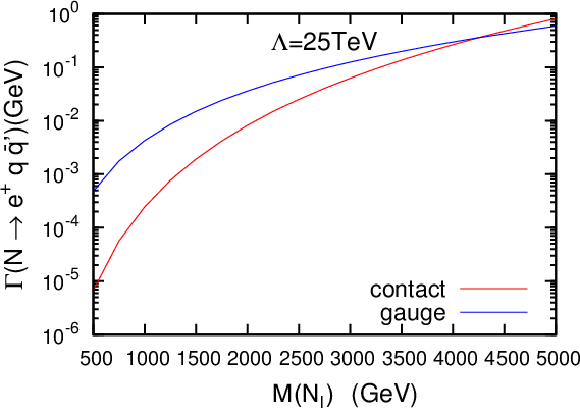
png pdf |
Figure 3-c:
Decay amplitude of the heavy composite Majorana neutrino to a lepton and two quarks, for Λ= 25 TeV, as a function of its mass, obtained with CalcHEP (v3.6) [29]. The x-axis range has been restricted to emphasize the interplay. |
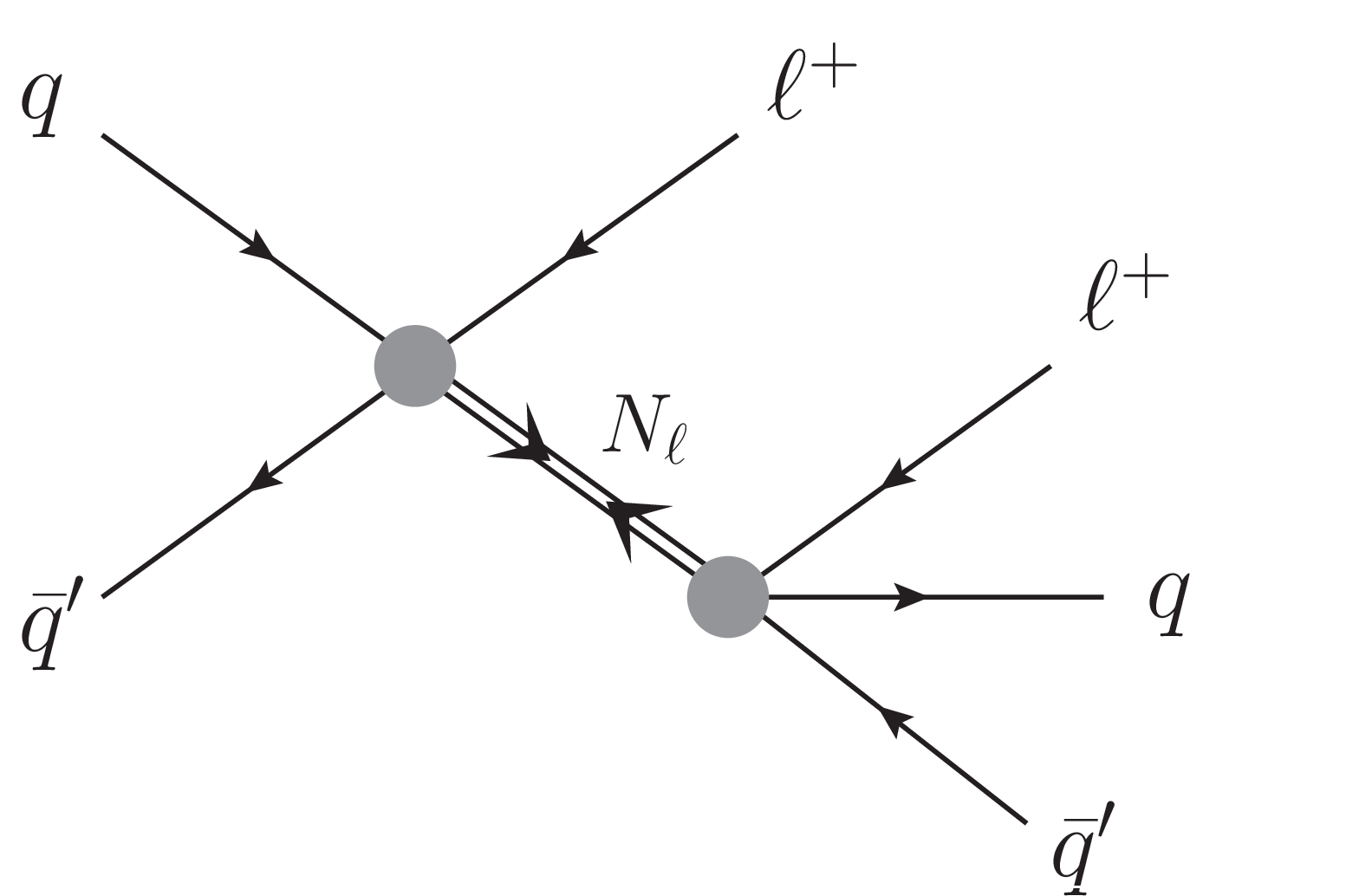
png pdf |
Figure 4:
The Feynman diagram of the process for the production and decay of a heavy composite Majorana neutrino, according to the decay chain pp→ℓNℓ→ℓℓqˉq′. |
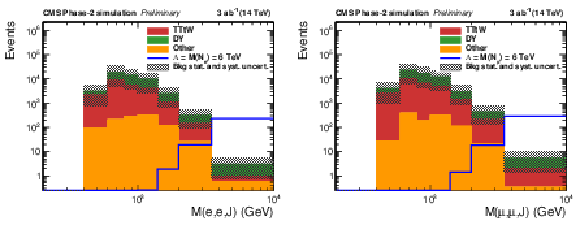
png pdf |
Figure 5:
Distribution of the variable M(ℓℓJ) of backgrounds (stacked plots) and expected signal (lines) in the signal region, considering the model parameters Λ=M(Nℓ)= 6 TeV, for the eeqˉq′ channel (left) and for the μμqˉq′ channel (right). The background statistical and systematic uncertainties have been combined. |

png pdf |
Figure 5-a:
Distribution of the variable M(ℓℓJ) of backgrounds (stacked plots) and expected signal (lines) in the signal region, considering the model parameters Λ=M(Nℓ)= 6 TeV, for the eeqˉq′ channel. The background statistical and systematic uncertainties have been combined. |

png pdf |
Figure 5-b:
Distribution of the variable M(ℓℓJ) of backgrounds (stacked plots) and expected signal (lines) in the signal region, considering the model parameters Λ=M(Nℓ)= 6 TeV, for the μμqˉq′ channel. The background statistical and systematic uncertainties have been combined. |

png pdf |
Figure 6:
The expected statistical significance for both the eeqˉq′ (red line) and μμqˉq′ (blue line) channel for the case Λ=M(Nℓ). The gray solid (dotted) line represents 5 (3) standard deviations, respectively. |
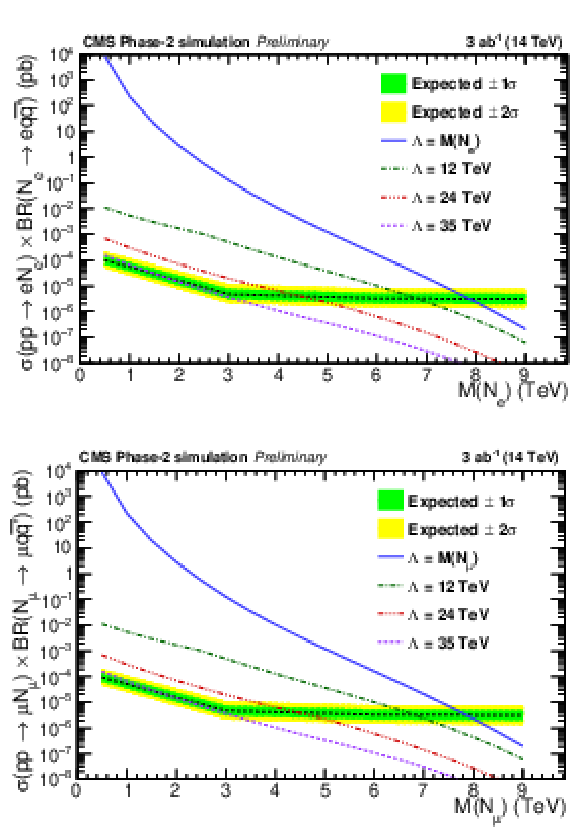
png pdf |
Figure 7:
The expected 95% CL upper limits (black dotted lines) on σ(pp→ℓNℓ)×B(Nℓ→ℓqˉq′), obtained in the analysis of the eeqˉq′ (top) and the μμqˉq′ (bottom) final states, as a function of the mass of the heavy composite Majorana neutrino. The corresponding green and yellow bands represent the expected variation of the limit to one and two standard deviation(s). The solid blue curve indicates the theoretical prediction of Λ=M(Nℓ). The textured curves give the theoretical predictions for Λ values ranging from 12 to 35 TeV. |

png pdf |
Figure 7-a:
The expected 95% CL upper limits (black dotted lines) on σ(pp→ℓNℓ)×B(Nℓ→ℓqˉq′), obtained in the analysis of the eeqˉq′ final state, as a function of the mass of the heavy composite Majorana neutrino. The corresponding green and yellow bands represent the expected variation of the limit to one and two standard deviation(s). The solid blue curve indicates the theoretical prediction of Λ=M(Nℓ). The textured curves give the theoretical predictions for Λ values ranging from 12 to 35 TeV. |
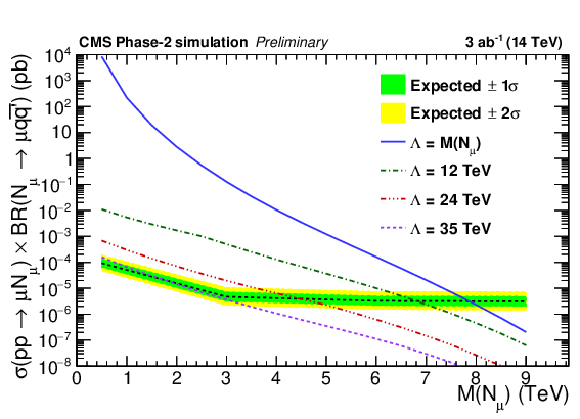
png pdf |
Figure 7-b:
The expected 95% CL upper limits (black dotted lines) on σ(pp→ℓNℓ)×B(Nℓ→ℓqˉq′), obtained in the analysis of the μμqˉq′ final state, as a function of the mass of the heavy composite Majorana neutrino. The corresponding green and yellow bands represent the expected variation of the limit to one and two standard deviation(s). The solid blue curve indicates the theoretical prediction of Λ=M(Nℓ). The textured curves give the theoretical predictions for Λ values ranging from 12 to 35 TeV. |

png pdf |
Figure 8:
The expected 95% CL lower limits (black lines) on the compositeness scale Λ, obtained in the analysis of the eeqˉq′ (top) and the μμqˉq′ (bottom) final states, as a function of the mass of the heavy composite Majorana neutrino. The gray zone corresponds to the phase space Λ<M(Nℓ) not allowed by the model. |
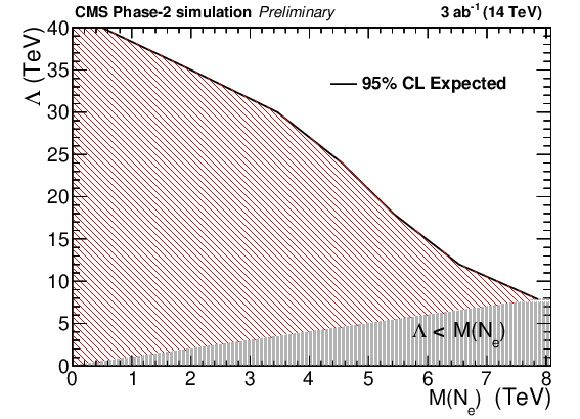
png pdf |
Figure 8-a:
The expected 95% CL lower limits (black lines) on the compositeness scale Λ, obtained in the analysis of the eeqˉq′ final state, as a function of the mass of the heavy composite Majorana neutrino. The gray zone corresponds to the phase space Λ<M(Nℓ) not allowed by the model. |

png pdf |
Figure 8-b:
The expected 95% CL lower limits (black lines) on the compositeness scale Λ, obtained in the analysis of the μμqˉq′ final state, as a function of the mass of the heavy composite Majorana neutrino. The gray zone corresponds to the phase space Λ<M(Nℓ) not allowed by the model. |
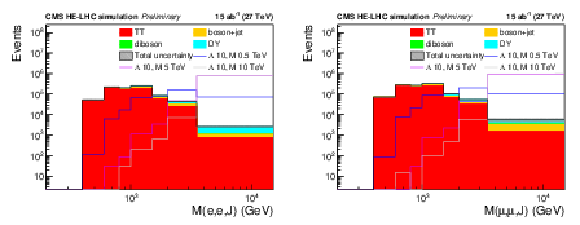
png pdf |
Figure 9:
Distribution of the invariant mass of two leptons and leading large-radius jet of backgrounds and three signal samples for the eeqˉq′ channel (left) and μμqˉq′ channel (right) for the HE-LHC. The error bands are given by the combination of systematic and statistical uncertainties. |
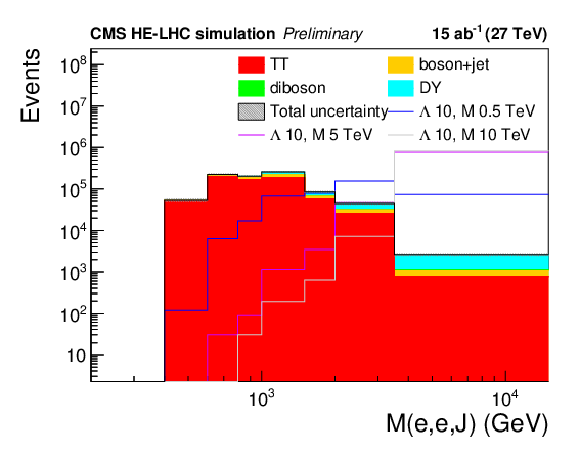
png pdf |
Figure 9-a:
Distribution of the invariant mass of two leptons and leading large-radius jet of backgrounds and three signal samples for the eeqˉq′ channel for the HE-LHC. The error bands are given by the combination of systematic and statistical uncertainties. |
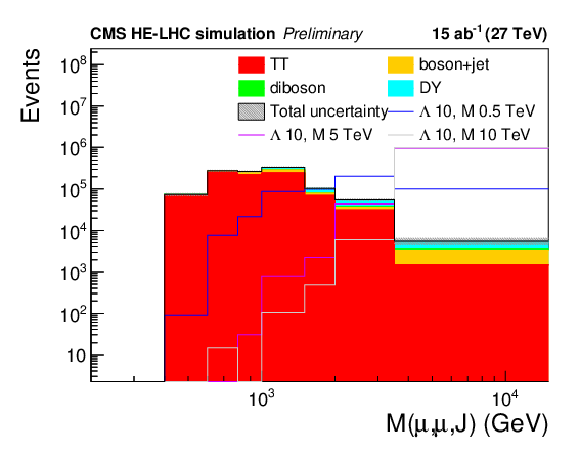
png pdf |
Figure 9-b:
Distribution of the invariant mass of two leptons and leading large-radius jet of backgrounds and three signal samples for the μμqˉq′ channel for the HE-LHC. The error bands are given by the combination of systematic and statistical uncertainties. |

png pdf |
Figure 10:
The expected statistical significance for the HE-LHC projection of the eeqˉq′ (red line) and the μμqˉq′ (blue line) channel for the case Λ=M(Nℓ). The gray solid (dotted) line represents 5 (3) standard deviations, respectively. |
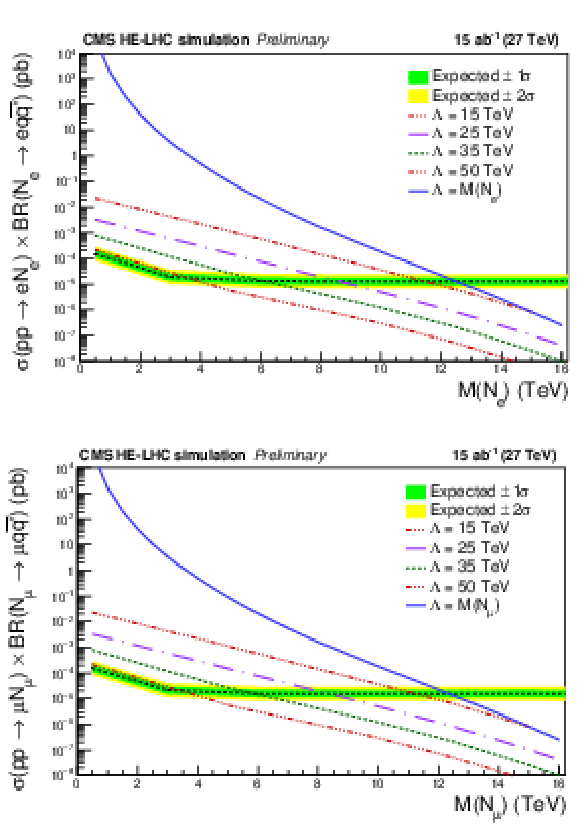
png pdf |
Figure 11:
The expected 95% CL upper limits for the HE-LHC projection of the eeqˉq′ channel (top) and the μμqˉq′ channel (bottom). The cross section limits are higher in the HE case because of the much larger background expectation at 27 TeV. |
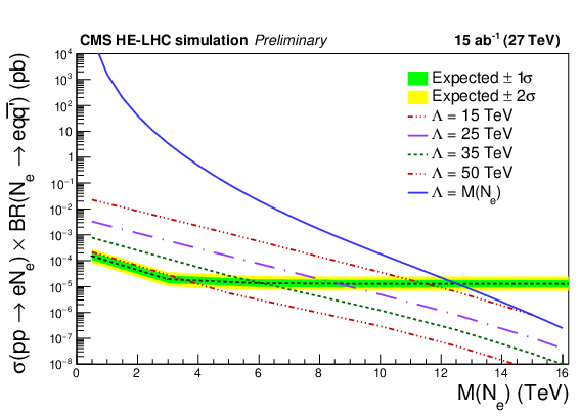
png pdf |
Figure 11-a:
The expected 95% CL upper limits for the HE-LHC projection of the eeqˉq′ channel. The cross section limits are higher in the HE case because of the much larger background expectation at 27 TeV. |
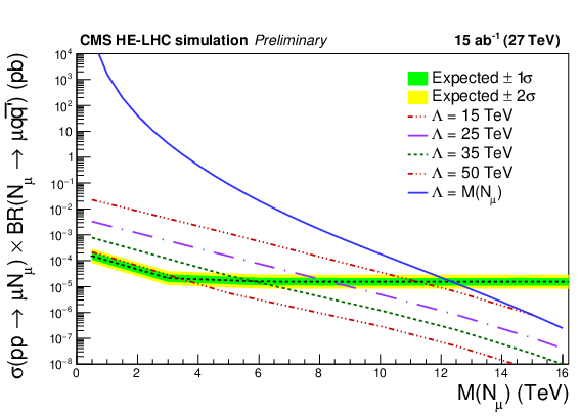
png pdf |
Figure 11-b:
The expected 95% CL upper limits for the HE-LHC projection of the μμqˉq′ channel. The cross section limits are higher in the HE case because of the much larger background expectation at 27 TeV. |
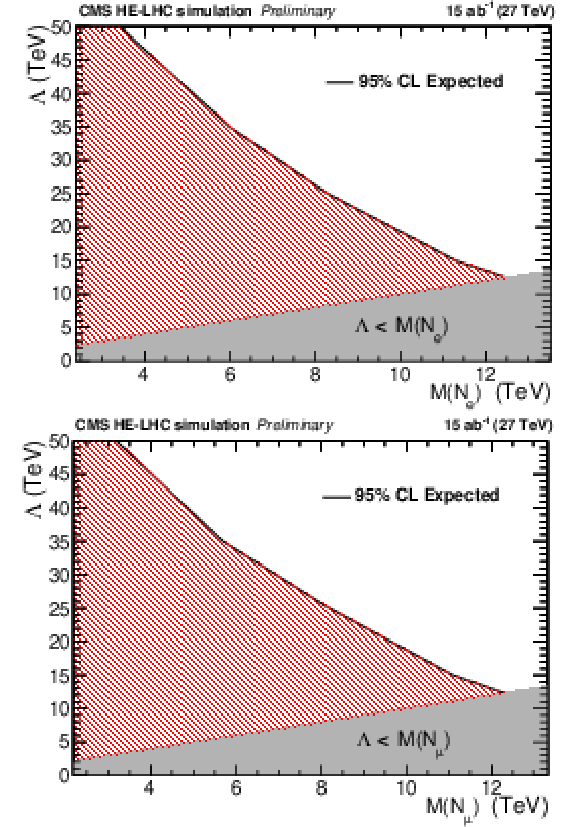
png pdf |
Figure 12:
The expected 95% CL lower limits (black lines) on the compositeness scale Λ, obtained in the analysis of the eeqˉq′ (top) and the μμqˉq′ (bottom) final states, as a function of the mass of the heavy composite Majorana neutrino for the HE-LHC projection. The red shaded zone highlights the excluded parameter space. The gray zones are not allowed by the model. |
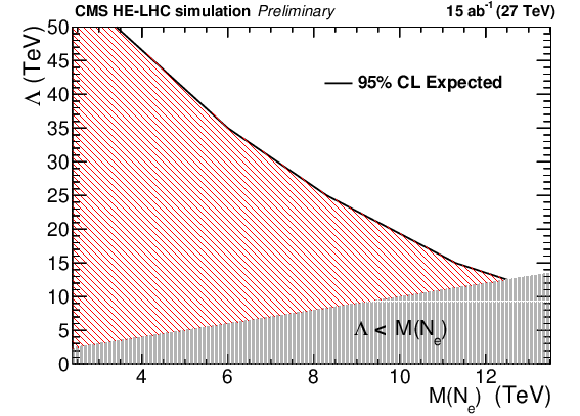
png pdf |
Figure 12-a:
The expected 95% CL lower limits (black lines) on the compositeness scale Λ, obtained in the analysis of the eeqˉq′ final state, as a function of the mass of the heavy composite Majorana neutrino for the HE-LHC projection. The red shaded zone highlights the excluded parameter space. The gray zones are not allowed by the model. |
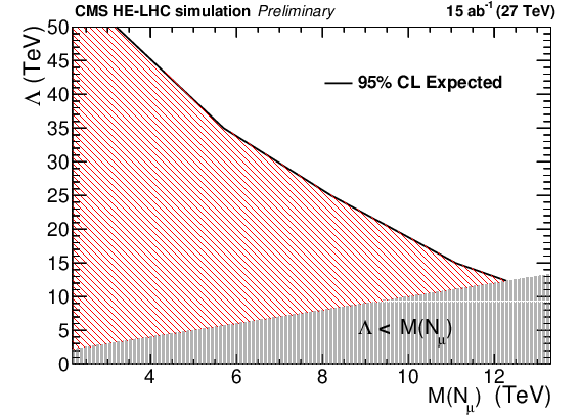
png pdf |
Figure 12-b:
The expected 95% CL lower limits (black lines) on the compositeness scale Λ, obtained in the analysis of the μμqˉq′ final state, as a function of the mass of the heavy composite Majorana neutrino for the HE-LHC projection. The red shaded zone highlights the excluded parameter space. The gray zones are not allowed by the model. |
| Tables | |
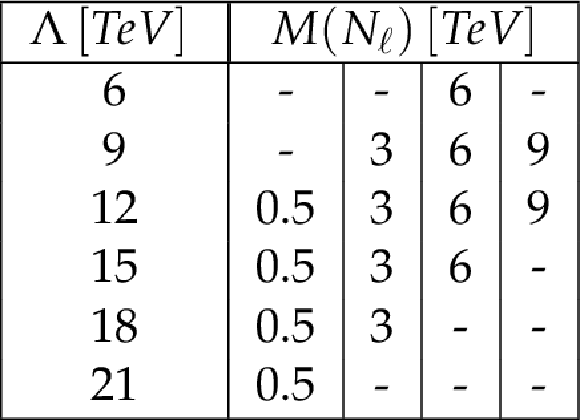
png pdf |
Table 1:
Parameters used in the HL-LHC analysis, ℓ=e,μ. |

png pdf |
Table 2:
List of systematic uncertainties used in the present analysis. |
| Summary |
| Studies have been conducted of the expected performance at the HL-LHC and at the HE-LHC of a search for a composite Majorana neutrino. The study has been carried out considering a heavy composite Majorana neutrino produced in association with a lepton and decaying into a same-flavor lepton plus two quarks, with the requirement of two leptons and at least one large-radius jet in the signal region. The HL-LHC running conditions and Phase-2 detector allow a significant extension of the parameter space that can be probed. |
| References | ||||
| 1 | J. C. Pati, A. Salam, and J. A. Strathdee | Are quarks composite? | PLB 59 (1975) 265 | |
| 2 | O. W. Greenberg and C. A. Nelson | Composite models of leptons | PRD 10 (1974) 2567 | |
| 3 | O. W. Greenberg and J. Sucher | A quantum structure dynamic model of quarks, leptons, weak vector bosons, and Higgs mesons | PLB 99 (1981) 339 | |
| 4 | E. Eichten, K. D. Lane, and M. E. Peskin | New tests for quark and lepton substructure | PRL 50 (1983) 811 | |
| 5 | M. Abolins et al. | Testing the Compositeness of Quarks and Leptons | in Elementary Particles and Future Facilities (Snowmass 1982), p. 274 1982eConf C8206282 | |
| 6 | H. Harari | Composite models for quarks and leptons | PR 104 (1984) 159 | |
| 7 | H. Terazawa | t-quark mass predicted from a sum rule for lepton and quark masses | PRD 22 (1980) 2921, . [Erratum: \DOI10.1103/PhysRevD.41.3541] | |
| 8 | N. Cabibbo, L. Maiani, and Y. Srivastava | Anomalous Z decays: Excited leptons? | PLB 139 (1984) 459 | |
| 9 | U. Baur, M. Spira, and P. M. Zerwas | Excited quark and lepton production at hadron colliders | PRD 42 (1990) 815 | |
| 10 | O. Panella, C. Carimalo, and Y. N. Srivastava | Production of like sign dileptons in pp collisions through composite Majorana neutrinos | PRD 62 (2000) 015013 | hep-ph/9903253 |
| 11 | O. Panella and Y. N. Srivastava | Bounds on compositeness from neutrinoless double beta decay | PRD 52 (1995) 5308 | hep-ph/9411224 |
| 12 | O. Panella, C. Carimalo, Y. N. Srivastava, and A. Widom | Neutrinoless double beta decay with composite neutrinos | PRD 56 (1997) 5766 | hep-ph/9701251 |
| 13 | ATLAS Collaboration | Search for heavy neutrinos and right-handed w bosons in events with two leptons and jets in pp collisions at √s= 7 tev with the atlas detector | The European Physical Journal C 72 (2012) 1--22 | |
| 14 | ATLAS Collaboration | Search for heavy majorana neutrinos with the atlas detector in pp collisions at √s= 8 tev | Journal of High Energy Physics (2015) 1--44 | |
| 15 | ATLAS Collaboration | Search for excited leptons in proton-proton collisions at √s= 7~TeV with the ATLAS detector | PRD 85 (2012) 072003 | 1201.3293 |
| 16 | ATLAS Collaboration | Search for excited electrons and muons in √s= 8 TeV proton-proton collisions with the ATLAS detector | New J. Phys. 15 (2013) 093011 | 1308.1364 |
| 17 | CMS Collaboration | Search for excited leptons in pp collisions at √s= 7 TeV | PLB 720 (2013) 309 | CMS-EXO-11-034 1210.2422 |
| 18 | CMS Collaboration | Search for excited leptons in proton-proton collisions at √s= 8 TeV | JHEP 03 (2016) 125 | CMS-EXO-14-015 1511.01407 |
| 19 | CMS Collaboration | Search for excited leptons in the ℓℓγ final state at √s= 13 TeV | CMS-PAS-EXO-16-009 | CMS-PAS-EXO-16-009 |
| 20 | CMS Collaboration | Search for excited leptons in the ℓℓγ final state in proton-proton collisions at √s= 13 TeV | CMS-PAS-EXO-18-004 | CMS-PAS-EXO-18-004 |
| 21 | S. Biondini et al. | Phenomenology of excited doubly charged heavy leptons at LHC | PRD85 (2012) 095018 | 1201.3764 |
| 22 | R. Leonardi, O. Panella, and L. Fanò | Doubly charged heavy leptons at LHC via contact interactions | PRD90 (2014), no. 3, 035001 | 1405.3911 |
| 23 | R. Leonardi et al. | Hunting for heavy composite Majorana neutrinos at the LHC | EPJC76 (2016), no. 11, 593 | 1510.07988 |
| 24 | O. Panella et al. | Production of exotic composite quarks at the LHC | PRD96 (2017), no. 7, 075034 | 1703.06913 |
| 25 | M. Presilla, R. Leonardi, and O. Panella | Like-sign dileptons with mirror type composite neutrinos at the HL-LHC | 1811.00374 | |
| 26 | S. Biondini and O. Panella | Leptogenesis and composite heavy neutrinos with gauge mediated interactions | EPJC77 (2017), no. 9, 644 | 1707.00844 |
| 27 | K. H. K. Nakamura, K. Hagiwara et al. | Review of particle physics. | Journal of Physics G-Nuclear and Particle Physics 37 (2010) 1 | |
| 28 | R. Leonardi et al. | Hunting for heavy composite Majorana neutrinos at the LHC | EPJC 76 (2016) 593 | 1510.07988 |
| 29 | A. Belyaev, N. D. Christensen, and A. Pukhov | CalcHEP 3.4 for collider physics within and beyond the Standard Model | CPC 184 (2013) 1729--1769 | 1207.6082 |
| 30 | CMS Collaboration | Search for a heavy composite Majorana neutrino in the final state with two leptons and two quarks at √s= 13 TeV | PLB775 (2017) 315--337 | CMS-EXO-16-026 1706.08578 |
| 31 | CMS Collaboration | The CMS Experiment at the CERN LHC | JINST 3 (2008) S08004 | CMS-00-001 |
| 32 | G. Apollinari et al. | High-Luminosity Large Hadron Collider (HL-LHC) : Preliminary Design Report | ||
| 33 | D. Contardo et al. | Technical Proposal for the Phase-II Upgrade of the CMS Detector | technical report | |
| 34 | K. Klein | The Phase-2 Upgrade of the CMS Tracker | technical report | |
| 35 | C. Collaboration | The Phase-2 Upgrade of the CMS Barrel Calorimeters Technical Design Report | CERN-LHCC-2017-011. CMS-TDR-015, CERN, Geneva, Sep | |
| 36 | C. Collaboration | The Phase-2 Upgrade of the CMS Endcap Calorimeter | CERN-LHCC-2017-023. CMS-TDR-019, CERN, Geneva, Nov | |
| 37 | C. Collaboration | The Phase-2 Upgrade of the CMS Muon Detectors | CERN-LHCC-2017-012. CMS-TDR-016, CERN, Geneva, Sep | |
| 38 | CMS Collaboration | Expected performance of the physics objects with the upgraded CMS detector at the HL-LHC | ||
| 39 | NNPDF Collaboration | Parton distributions for the LHC Run II | JHEP 04 (2015) 040 | 1410.8849 |
| 40 | J. Alwall et al. | The automated computation of tree-level and next-to-leading order differential cross sections, and their matching to parton shower simulations | JHEP 07 (2014) 079 | 1405.0301 |
| 41 | J. Pumplin et al. | New generation of parton distributions with uncertainties from global qcd analysis | Journal of High Energy Physics 2002 (2002), no. 07, 012 | |
| 42 | CMS Collaboration | Search for a heavy composite majorana neutrino in the final state with two leptons and two quarks at √s= 13 TeV | Physics Letters B 775 (2017) 315 -- 337 | |
| 43 | T. Sjostrand et al. | An Introduction to PYTHIA 8.2 | CPC 191 (2015) 159--177 | 1410.3012 |
| 44 | DELPHES 3 Collaboration | DELPHES 3, A modular framework for fast simulation of a generic collider experiment | JHEP 02 (2014) 057 | 1307.6346 |
| 45 | GEANT4 Collaboration | GEANT4: A Simulation toolkit | NIMA 506 (2003) 250 | |
| 46 | J. Allison et al. | Geant4 developments and applications | IEEE Trans. Nucl. Sci. 53 (2006) 270 | |
| 47 | CMS Collaboration | Particle-flow reconstruction and global event description with the CMS detector | JINST 12 (2017), no. 10, P10003 | CMS-PRF-14-001 1706.04965 |
| 48 | M. Cacciari, G. P. Salam, and G. Soyez | The anti-kt jet clustering algorithm | JHEP 04 (2008) 063 | 0802.1189 |
| 49 | M. Cacciari, G. P. Salam, and G. Soyez | FastJet user manual | EPJC 72 (2012) 1896 | 1111.6097 |
| 50 | D. Bertolini, P. Harris, M. Low, and N. Tran | Pileup Per Particle Identification | JHEP 10 (2014) 059 | 1407.6013 |
| 51 | G. Cowan, K. Cranmer, E. Gross, and O. Vitells | Asymptotic formulae for likelihood-based tests of new physics | EPJC71 (2011) 1554 | 1007.1727 |
| 52 | A. L. Read | Presentation of search results: the cls technique | JPG: Nucl. Part. Phys. 28 (2002) 2693 | |
| 53 | ATLAS and CMS Collaborations" | Recommendations for Systematic Uncertainties HL-LHC | link | |
| 54 | C. Helsens | FCC simulation based on madgraph gridpacks or standalone pythia8 | 2018 \url http://fcc-physics-events.web.cern.ch/fcc-physics-events/ | |

|
Compact Muon Solenoid LHC, CERN |

|

|

|

|

|

|